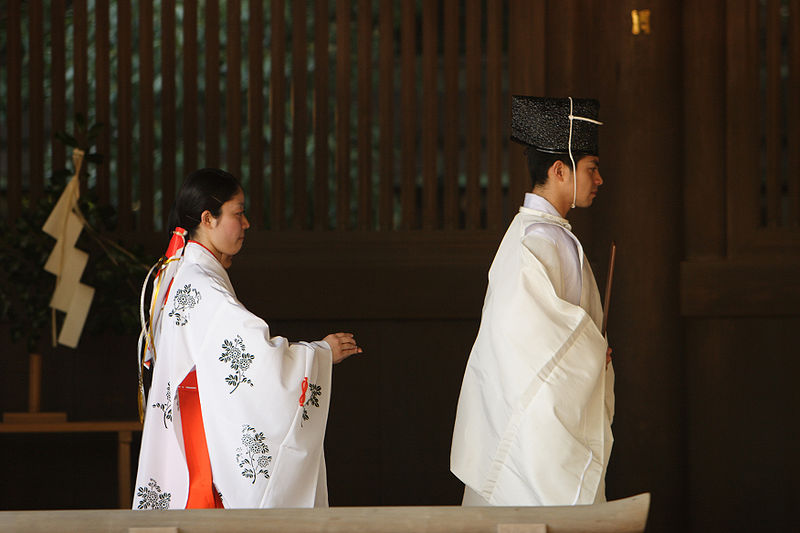For many Americans, black seems to be the most common color to wear as funeral attire. Why is that? And why do some religious and cultural groups tend to wear white to funerals? Much of the color choice within religious groups has to do with personal interpretations about death and the afterlife.
The custom of wearing black funeral attire goes back to the days of the Roman Empire when they would wear dark togas as a symbol for mourning. The popularity of wearing black skyrocketed during the Renaissance and throughout the 19th century, especially for women. During mourning periods and funeral services, mourners wore everything from clothing and headdresses, to unique jewelry, such as lockets and brooches, that kept pieces of lost loved ones’ hair close to the heart. Interestingly enough, in rural parts of Latin America and the Mediterranean, widows will also wear black for the remainders of their lives whereas other family members wear the color for an extended period of mourning.
Faith in a particular religion plays a major role in whether black or white is worn at a funeral. With around 76% of the American population identifying themselves as Christians, black funeral attire remains popular in the United States because it tends to be the common choice for Christian mourning and funerals. For the less than four percent who practice Hinduism or Buddhism in the United States, however, the popular color for funeral attire tends to be white, which symbolizes
purity. Therefore, in countries where Hinduism and Buddhism are practiced more prevalently, it would not be uncommon to witness a funeral where everyone wears white. In Japan’s past, a country where a combination of Shinto and Buddhist beliefs are practiced, people commonly wore white suits or kimonos. Nowadays, however, most Japanese people have transitioned to wearing black funeral attire like their western counterparts. One religion, Islam, remains neutral when it comes to what color should be worn at funerals. In lieu of a focus on clothing color, attendees are expected to not wear any elaborate jewelry as well as dressing modestly as is standard in Muslim tradition.
Essentially, the type of attire expected will vary because every funeral is unique. Have you been asked to attend a funeral wearing any other colors or attire requirements?
You may also enjoy:

 Why Do We Wear Black Funeral Attire Versus White?
Why Do We Wear Black Funeral Attire Versus White?




 Support Healthy Aging By Maintaining Balance — On One Leg
Support Healthy Aging By Maintaining Balance — On One Leg
 “Wild Geese” by Mary Oliver
“Wild Geese” by Mary Oliver
















The black ironically matches with the colour of the deity Yamha and his chariot buffalow. The Crow bird is also black who takes the ritual food to the departed. but by and large North indians practice white dress code and in south india women widows attire is white whole of their life hence normally women never wear white as done in North india.
Report this comment
Hi Arunthangam,
Thanks for the comment and yes there is differences in ritual colors around the world. This post focuses on the US but it is nice to have other ritual colors added to the viewpoint.
Thanks!
Suzette
Report this comment
Thank you for the information. All my life I never knew the reason for black attire at funerals.
Report this comment
Thanks for the comment Emma. I never knew the roots of the tradition either!
Report this comment
Like it
Report this comment
Sounds like a Catholic thing..
Report this comment
It seems to me that death is not resembled by the color black. I think the afterlife is light, not black. It would sure make me feel better if everyone would wear something light or vibrant, sheer or glowing, because I expect my afterlife to be just that. I’m a Baptist btw.
Report this comment
You discuss some of the religious traditions, but never explain why certain traditions wear white and others black. You state, “Much of the color choice within religious groups has to do with personal interpretations about death and the afterlife.” But you never explain those interpretations which are, by the way, normative not personal. This article is a waste of time.
Report this comment
what an asshole to take your time to say something so negative at the end.
Report this comment
I was also looking for the history to why filipinos wear white during burials since I’m about to attend one tomorrow; unfortunately I can’t find any forums that discusses the roots of the tradition. So I opted to read this topic to give atleast an answer to another medium of wearing Black in the US. Thanks, was very informative.
Report this comment
PS; Majority of the filipinos are Catholics & christians. All the Burial I’ve attended in my life has had wearing White clothes as the norm entirely.
Report this comment
I learned that black was worn to avoid demons spirits from noticing the individual attending the burial. The wicked spirit would pass by the one with black attire. However, a chance of demon possession to those not in black.
Report this comment
My, my, so far seems superstitious – as well as merely individual interpretations.
Report this comment
Well I was requested to wear bright colorful clothing for a funeral and I am a Christian. And I liked that idea because if the person who died was a happy person why would they want you to wear black sad colors.
Report this comment
I think whomever is in charge of the services dictates the colors to wear
The wife or Mother or other family member.
Report this comment
These days I think that is very true, Candy, especially here in the U.S., where people are breaking away from the “traditional” funeral and creating their own rites and rituals. More and more people are opting to ask that people attending a funeral or memorial to wear a certain color, or to shun black and navy (or white) and come in something more colorful. I think it has a lot to do with our moving towards the idea of a service that celebrates someone’s life rather than simply mourning their death.
Report this comment